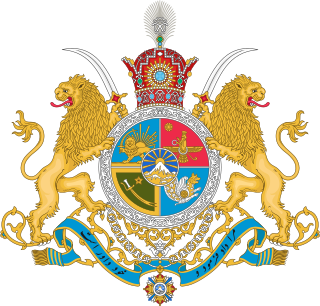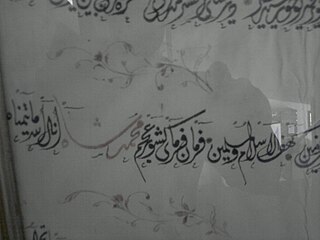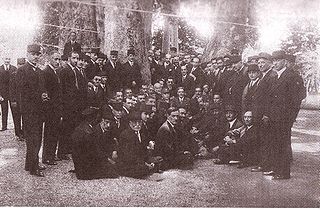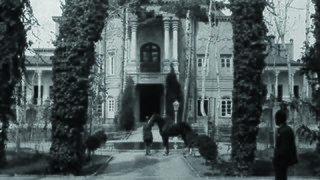The Persians are an Iranian ethnic group who comprise over half of the population of Iran. They share a common cultural system and are native speakers of the Persian language as well as of the languages that are closely related to Persian.

Shah is a royal title that was historically used by the leading figures of Iranian monarchies. It was also used by a variety of Persianate societies, such as the Ottoman Empire, the Kazakh Khanate, the Khanate of Bukhara, the Emirate of Bukhara, the Mughal Empire, the Bengal Sultanate, historical Afghan dynasties, and among Gurkhas. Rather than regarding himself as simply a king of the concurrent dynasty, each Iranian ruler regarded himself as the Shahanshah or Padishah in the sense of a continuation of the original Persian Empire.

Reza Shah Pahlavi was an Iranian military officer and the founder of the Pahlavi dynasty. As a politician, he previously served as minister of war and prime minister of Qajar Iran and subsequently reigned as Shah of Pahlavi Iran from 1925 until he was forced to abdicate after the Anglo-Soviet invasion of Iran in 1941. He was succeeded by his eldest son, Mohammad Reza Shah. A modernizer, Reza Shah clashed with the Shia clergy, but also introduced many social, economic, and political reforms during his reign, ultimately laying the foundation of the modern Iranian State. Therefore, he is regarded by many as the founder of modern Iran.

The Pahlavi dynasty is an Iranian royal dynasty that ruled for almost 54 years between 1925 and 1979. The dynasty was founded by Reza Shah Pahlavi, a non-aristocratic Mazanderani soldier in modern times, who took on the name of the Pahlavi language spoken in the pre-Islamic Sasanian Empire to strengthen his nationalist credentials.
This article focuses on the status of ethnic minorities in contemporary Iran.

Ajam is an Arabic word meaning mute. It generally refers to non-Arabs, including those whose mother tongue is not Arabic. During the Arab conquest of Persia, the term became a racial pejorative. In many languages, including Persian, Turkish, Urdu–Hindi, Azerbaijani, Bengali, Kurdish, Gujarati, Malay, Punjabi, and Swahili, Ajam and Ajami refer to Iran and Iranians respectively.
Iranian Canadians or Persian Canadians are Canadians of Iranian origin. From the 2016 Canadian census, the main communities can be found in Southern Ontario, British Columbia, and Quebec. The vast majority, however, live in northern suburbs of Toronto such as Richmond Hill, Vaughan, Markham, and Thornhill, and in certain municipalities of Vancouver, including North Vancouver, West Vancouver, Burnaby, and Coquitlam. As of 2016 a total of 97,110 Iranians reside in the Greater Toronto Area, 46,255 in the Greater Vancouver Area, and 23,410 in the Greater Montreal Area, with the remainder spread out in the other major cities of Canada, based on the 2016 Canadian Census. These numbers represent the people who stated "Iranian" as their single or joint ethnic origin in the census survey.

Iranian Americans are citizens or nationals of the United States who are of Iranian ancestry.

In the Western world, Persia was historically the common name used for Iran. On the Nowruz of 1935, Reza Shah officially asked foreign delegates to use the Persian term Iran, the endonym of the country, in formal correspondence. Subsequently, the common adjective for citizens of Iran changed from Persian to Iranian. In 1959, the government of Mohammad Reza Pahlavi, Reza Shah's son, announced that both "Persia" and "Iran" could be used interchangeably, in formal correspondence. However, the issue is still debated (see § Recent debate) among Iranians.

Asoristan was the name of the Sasanian province of Assyria and Babylonia from 226 to 637.

Justin Perkins was an American Presbyterian missionary and linguist. He was the first citizen of the United States to reside in Iran. He became known for his work among the people there as an "apostle to Persia," according to publications from the United States.
Iranians in the United Kingdom or British Iranians consist of people of Iranian nationality who have settled in the United Kingdom, as well as British residents and citizens of Iranian heritage. Iranians in the United Kingdom are referred to by hyphenated terms such as British-Iranians, British-Persians, Iranian-Britons, or Persian-Britons. At the time of the 2011 census, 84,735 Iranian-born people resided in the UK. In 2017, the Office for National Statistics estimated the Iranian-born population to be 70,000.
Religion in Iran has been shaped by multiple religions and sects over the course of the country's history. Zoroastrianism was the main followed religion during the Achaemenid Empire, Parthian Empire, and Sasanian Empire. Another Iranian religion known as Manichaeanism was present in Iran during this period. Jewish and Christian communities thrived, especially in the territories of northwestern, western, and southern Iran—mainly Caucasian Albania, Asoristan, Persian Armenia, and Caucasian Iberia. A significant number of Iranian peoples also adhered to Buddhism in what was then eastern Iran, such as the regions of Bactria and Sogdia.

Ethnic groups in the Middle East, in the 'transcontinental' region which is commonly a geopolitical term designating the intercontinental region comprising West Asia without the South Caucasus, and also comprising Egypt in North Africa. The region has historically been a crossroad of different cultures and languages. Since the 1960s, the changes in political and economic factors have significantly altered the ethnic composition of groups in the region. While some ethnic groups have been present in the region for millennia, others have arrived fairly recently through immigration. The largest socioethnic groups in the region are Arabs, Turks, Persians, Kurds, and Azerbaijanis but there are dozens of other ethnic groups that have hundreds of thousands, and sometimes millions of members.
Iranians in France include immigrants from Iran to France as well as their descendants of Iranian heritage or background. Iranians in France are referred to by hyphenated terms such as French-Iranians or French-Persians.
The majority of the population of Iran consists of Iranic peoples. The largest groups in this category include Persians and Kurds, with smaller communities including Gilakis, Mazandaranis, Lurs, Tats, Talysh, and Baloch.

The Pahlavi hat was an item of headgear for men introduced in the Imperial State of Iran by Reza Shah.
Swedish Iranians or Swedish Persians consist of people of Iranian nationality who have settled in Sweden, as well as Swedish residents and citizens of Iranian heritage. As of 2019, there were 80,136 residents of Sweden born in Iran, as well as 40,883 born in Sweden with at least one Iranian-born parent.

Gholam Reza Pahlavi was an Iranian prince and a member of the Pahlavi dynasty, as the son of Reza Shah and half-brother of Mohammad Reza Pahlavi, the last Shah of Iran.

The Davidkhanian Mansion is a historic estate in Qazvin, Iran. It was one of the estates of the Davidkhanian family. It is now owned by the Iranian government.











